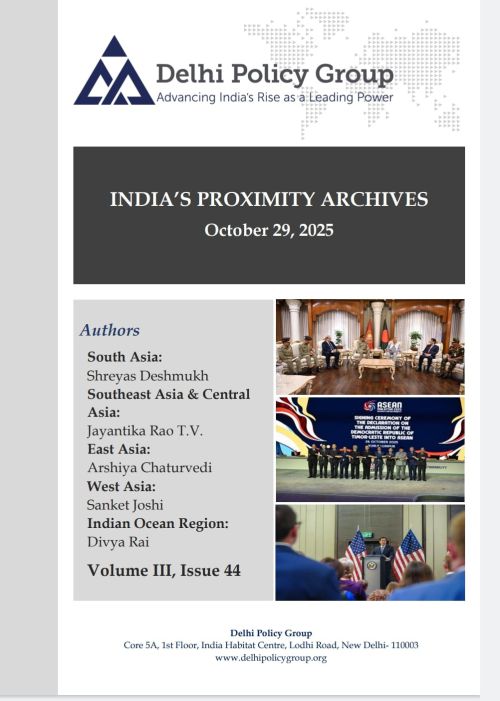India’s Proximity Archives
South Asia
Following the initial ceasefire agreement signed on October 19 between Afghanistan and Pakistan, the second round of discussions in Istanbul from October 25th to 28th did not yield a consensus. The leadership of both countries issued stern warnings regarding cross-border attacks, suggesting the potential for conflict escalation. Pakistan has refused to change its position, asserting that any alliance with the Taliban regime is contingent upon Kabul’s tangible actions against the Tehreek-e-Taliban Pakistan (TTP) and Baloch militant organisations. Afghan representatives rejected Pakistan’s proposal, asserting their unwillingness to accept any stipulations that would compromise national sovereignty, maintaining that they do not acknowledge the Durand Line as a national border and that the issues of TTP and Baluchistan are Pakistan’s internal affairs. While trade routes between the two countries remain closed, Pakistan persisted in deporting Afghan refugees.
Southeast Asia
Indian Prime Minister Narendra Modi declared the 21st century as the “century of India and ASEAN”, while highlighting that the partnership between the two sides goes beyond trade and is deeply rooted in cultural, historical, and civilisational ties, during his virtual address at the 22nd ASEAN-India Summit in Kuala Lumpur on October 26. He reaffirmed ASEAN’s role as the “main pillar” of India’s Act East Policy and warmly welcomed Timor-Leste as the bloc’s eleventh member. Highlighting shared geography, values, and a collective identity within the Global South, Modi noted that India and ASEAN together represent one-fourth of the world’s population. He reiterated India’s steadfast support for ASEAN Centrality and its Indo-Pacific vision, underscoring a commitment to inclusive regional cooperation.
East Asia
On October 21, the Japanese parliament voted in both houses to elect Sanae Takaichi as its first female Prime Minister. This signifies a transformative moment in the country’s political history where leadership positions have traditionally been dominated by men. Takaichi’s leadership, particularly her hardline approach to addressing Japan’s critical challenges, including economic troubles, the LDP’s declining popularity, and immigration concerns, will be put to the test in the months to come.
West Asia
In response to a ceasefire violation by Hamas, the Israel Defence Forces conducted an airstrike in Gaza on October 28, reportedly killing 26 Palestinians. President Donald Trump maintained that the US-backed ceasefire in Gaza is not at risk and Israel has every right to defend itself if its security is threatened. Meanwhile, US Secretary of State Marco Rubio, in his remarks in Jerusalem on October 24, informed that the US is gathering inputs for a possible United Nations resolution on an international agreement to authorise a multinational force in Gaza. Israeli Prime Minister Benjamin Netanyahu informed that Israel will only cooperate with countries that are comfortable working with the IDF as part of the International Stabilisation Force in Gaza and refused to accept the presence of Turkish armed forces.
Central Asia
On October 27, Kazakhstan’s President Kassym-Jomart Tokayev expressed support for Azerbaijan’s participation in the upcoming Central Asia-U.S. Summit in Washington, scheduled for November 6. In an exclusive comment to Azerbaijani outlet Minval Politika, Tokayev praised Azerbaijan’s regional role and even called the country a “natural part of Greater Central Asia.” The summit, held under the C5+1 format, traditionally includes the United States and the five Central Asian republics—Kazakhstan, Kyrgyzstan, Tajikistan, Turkmenistan, and Uzbekistan—who have all received formal invitations from President Donald Trump. While Azerbaijan’s inclusion remains uncertain and no official invitation has been announced, Tokayev’s endorsement signals a growing openness among Central Asian leaders to expand the framework of regional cooperation beyond its conventional boundaries.
Indian Ocean Region
Mahe’, the first of eight Anti-Submarine Warfare Shallow Watercrafts (ASW SWC) built by Cochin Shipyard Limited (CSL) in Kochi, was delivered to the Indian Navy on October 23, 2025. Named after the historic port town in the Union Territory of Puducherry, ‘Mahe’ reflects India’s rich maritime heritage and growing self-reliance in naval shipbuilding, with over 80% indigenous content. The vessel measures approximately 78 metres in length, displaces around 1,100 tonnes, and is equipped for underwater surveillance, low-intensity maritime operations, anti-submarine warfare in coastal waters, and has advanced mine-laying capabilities. Its armament includes torpedoes, multifunctional anti-submarine rockets, and advanced radar and sonar systems.



